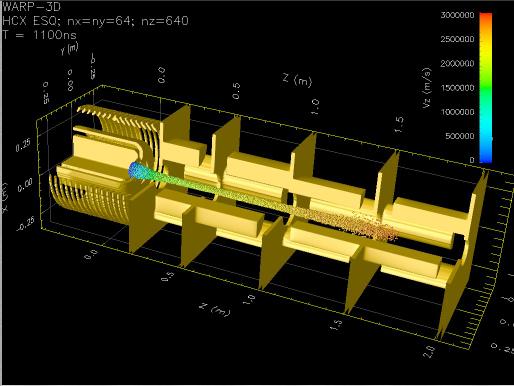Simulation Movies
![]() Self-consistent 3-D simulation of the
HCX experiment magnetic
section with electrons
Self-consistent 3-D simulation of the
HCX experiment magnetic
section with electrons
These rendering of WARP simulation of an HCX experiment shows the beam propagating through the magnetic section, hitting a diagnostic plate and producing copious "primary" electrons which propagate upstream and generate "secondary" electrons when hitting walls.
- Movie 1 (QuickTime - 311 MB)
The upper left plot shows both an XZ view (upper half) and a YZ view (lower half) of the particles (black=ions, red=primary electrons, blue=secondary electrons); note that the colors are drawn in an order such that many of the primary electrons and beam ions are obscured. The plot immediately below shows the line charge density (microCoul/m) for the ions (black), primary electrons from the plate (red), secondary electrons from the walls (blue), and the sum of primary+secondary electrons (orange) as functions of Z. The four plots in the upper right are magnified views of the XZ (upper two) and YZ (lower two) projections in the vicinity of the fourth quadrupole, where an instability develops. In the left column of the foursome, the green lines are potential contours, and only primary electrons are shown; in the right column, only secondary electrons are shown. The three plots in the bottom row are views of particles in XY "slices" in (respectively) the second, third and fourth magnet. This movie shows that secondary electrons are essential to the understanding of the dynamics, that the overall population of electrons diminishes as one moves farther upstream from the end plate, and that an instability develops in the fourth quadrupole; this instability is under active study.
- Movie 2 (MPEG4 - 58 MB)
This movie shows 3-D renderings of the beam (green isosurface) propagating through the last magnetic quadrupole and generating electrons when hitting the end wall. Potential isosurfaces are displayed in the upper left quadrant. Electrons (primary+secondary), primary electrons and secondary electrons are displayed respectively in the upper-right, lower-left and lower-right quadrant, colored according to their density. Bunching of electrons that produce the oscillations observed in Movie 1 is easily observable.
![]() End-to-end simulation of the
HCX experiment (QuickTime - 116 MB or
40 MB)
End-to-end simulation of the
HCX experiment (QuickTime - 116 MB or
40 MB)
This WARP simulation shows the beam emitted from the source and then propagating through the three sections of the HCX: injector, matching section, and electrostatic-quadrupole transport lattice. The injector modeling employs a 3-D time-dependent description and uses an experimentally measured waveform for the beam extraction voltage. Once the beam reaches equilibrium, macroparticles are accumulated at the exit plane of the injector until sufficient statistics for high-fidelity simulation of the downstream system are attained. The accumulated set of macroparticles is then used to initiate a Z-dependent XY "slice" calculation of the matching section and the lattice. The slice mode of simulation assumes that the mid-pulse sections of the beam are well described by a steady flow of particles.
The movie contains three parts.

- Presentation
The movie begins with a view of a technical drawing of the accelerator where each section accounts for about a third of the entire machine. A brief animation progressively reveals a 3-D rendering of the injector structures accompagnied by a transtition of the camera position to a more conveninent point of view, and the section ends with the disappearance of the technical drawing.
- 3-D time-dependent simulation of injector
As a consequence of the time-dependent rise of the extraction voltage (which is not shown in the movie), the beam is extracted from the emitter and propagates through a set of electrostatic quadrupoles, where it is accelerated and transversely confined. The beam head is "mismatched" and expands transversely to the point where particles from the head hit the structure. The main body of the beam is well matched and reaches equilibrium.
- 3-D reconstruction of beam in matching section and lattice
A transverse beam slice, constructed by accumulating macropaticles from the 3-D injector simulation, is followed through the HCX lattice as a function of Z. The beam undergoes strong transverse compression in the matching section and then propagates through the electrostatic-quadrupole transport lattice. The 3-D view in the movie is constructed by stacking random samples of the slice at each station along Z.
![]() Transverse simulation of merging beamlets showing coordinate-space view
(QuickTime - 66 MB or
18 MB)
Transverse simulation of merging beamlets showing coordinate-space view
(QuickTime - 66 MB or
18 MB)
![]() Transverse simulation of merging beamlets showing XX' phase-space view (QuickTime -
4.5 MB)
Transverse simulation of merging beamlets showing XX' phase-space view (QuickTime -
4.5 MB)
For comments or questions contact WMSharp@lbl.gov or DPGrote@lbl.gov. Work described here was supported by the Office of Fusion Energy at the US Department of Energy under contracts DE-AC03-76SF00098 and W-7405-ENG-48. This document was last revised August, 2003.
